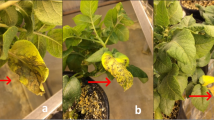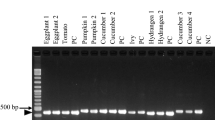Abstract
Three isolates of Metarhiziumanisopliae var. acridum, FI-985,from the spur-throated locust, Austracrisguttulosa from Australia, and QF-01 and QF-02both from Schistocerca piceifrons inMexico were compared. FI-985 had much largerconidia than the other two isolates and alsohad a different colony appearance. The twoMexican isolates showed small differences inconidial size and colony morphology. Over arange of 6 primers, RAPDs patterns were verysimilar in that the two Mexican isolates being identical, and FI-985 having some unique bandsonly with 2 primers. The 3 isolates were alsosimilar in growth profiles on agar plates, andat high temperatures (36°C), QF-01 didnot grow while the other two isolates grewslowly. All three isolates were similar invirulence for wingless grasshoppers, Phaulacridium vittatum, at 20–30°C but at 35°C, FI-985 was the mostvirulent and QF-01 the least over a range of 3doses. At 15°C, FI-985 was also the mostvirulent with QF-02 being least virulent. At30°C, the LD50 at 17 days rangedfrom 248 conidia for QF-02 to 501 conidia forFI-985, however the differences were notsignificant (p > 0.05). It is suggested thatconsideration should be given to using anexotic isolate such as FI-985 as a commerciallocust biopesticide in countries such asMexico, since the isolate is cheap to massproduce, more effective at higher temperaturescommon in tropical to subtropical Mexico, andrelatively resistant to UV.
Similar content being viewed by others
References
Abbott, W.S. 1925. A method of computing the effectiveness of an insecticide. J. Econ. Ent. 18: 265–267.
Baker, G.L. 1982. The seasonal abundance of dipterous and mermithid parasites of wingless grasshopper, Phaulacridium vittatum (Sjost.), in the Central Tablelands of New South Wales. In: K. Lee (ed), Proceedings of the 3rd Australian Applied Entomology Conference on Grassland Invertebrate Ecology. Adelaide, pp. 169–176.
Bateman, R.P., M. Carey, D. Batt, C. Prior, Y. Abraham, D. Moore, N. Jenkins and Y. Fenlon (1996). Screening for virulent isolates of entomopathogenic fungi against the desert locust, Schistocerca gregaria (Forskal). Biocontrol Sci. Technol. 6: 549–560.
Blanford S. and M.B. Thomas, 1999. Host thermal biology: the key to understanding insect pathogens interactions and microbial pest control? Agric. Forest Entomol. 1: 195–202.
Blanford S., M.B. Thomas and J. Langewald, 2000. Thermal ecology of Zonocerus variegatus and its effects on biocontrol using pathogens. Agric. Forest Entomol. 2: 3–10.
Bridge, P.D., M.A.J. Williams, C. Prior and R.R.M. Paterson, 1997. Molecular characterisation of isolates of Metarhizium from locust and grasshoppers. Biodiver. Conserv. 6: 177–189.
Driver, F., R.J. Milner and J.W.H. Trueman, 2000. A taxonomic revision of Metarhizium based on sequence analysis of ribosomal DNA. Mycol. Res. 104: 135–151.
Fargues J., M.S. Goettel, N. Smits, A. Ouedraogo, C. Vidal, L.A. Lacey, C.J. Lomer and R.M. Fargues, 1996. Variability in susceptibility to simulated sunlight of conidia among isolates of entomopathogenic Hyphomycetes. Mycopathologia 135: 171–181.
Fargues, J., A. Ouedraogo, M.S. Goettel and C.J. Lomer, 1997. Effects of temperature, humidity and inoculation method on susceptibility of Schistocerca gregaria to Metarhizium flavoviride. Biocontrol Sci. Tech. 7: 345–356.
Hernández-Velázquez, V.M. and R.L. Gutierrez, 2000. Formulacion y applicacion de cepas nativas de Metarhizium anisopliae var. acridum para el control de Schistocerca piceifrons en Mexico. Memoirs XXIII Congresso Nacional de Control Biologico, Guanajuato, Mexico, pp. 194–196.
Hernández-Velázquez, V.M., A.M. Berlanga-Padilla and E. Garza-Gonzales, 1997. Detection de Metarhizium flavoviride sobre Schistocerca piceifrons piceifrons (Orthoptera: Acididae) en la isla socorro, Archipielago de Revillagigedo, Mexico. Vedalia 4: 45–46.
Hunter, D.M., R.J. Milner, J.C. Scanlan and P.A. Spurgin, 1999. Aerial treatment of the migratory locust, Locusta migratoria (L.) (Orthoptera: Acrididae) with Metarhizium anisopliae (Deuteromycotina: Hyphomycetes) in Australia. Crop Protection 18: 699–704.
Hunter, D.M., R.J. Milner and P.A. Spurgin, 2001. Aerial treatment of the Australian plague locust, Chortoicetes terminifera (Orthoptera: Acrididae) with Metarhizium anisopliae (Deuteromycotina: Hyphomycetes). Bull. Ent. Res. 91: 93–99
Inglis, G.D., D.L. Johnson, K.J. Cheng and M.S. Goettel, 1997. Use of pathogen combinations to overcome constraints of temperature on entomopathogenic hyphomycetes against grasshoppers. Biol. Control 8: 143–152.
Inglis G.D., G.M. Duke, L.M. Kawchuk and M.S. Goettel, 1999. Influence of oscillating temperatures of the competitive infection and colonization of the migratory grasshopper by Beauveria bassiana and Metarhizium flavoviride. Biol. Control 14: 111–120.
Lee B.I., R. Bateman, L.I. Guoyou, L. Meng, and Y.A. Zheng (2000). Field trial on the control of grasshoppers in mountain grassland by oil formulation of Metarhizium flavoviride (In Chinese). Chinese J. Biolog. Contr. 16: 145–147.
Lomer, C.J., C. Prior and C. Kooyman, 1997. Development ofMetarhizium spp. for the control of grasshoppers and locusts. Mem. Entomol. Soc. Canada 171: 265–286.
Lomer, C.J., R.P. Bateman, D.L. Johnson, J. Langewald and M. Thomas, 2001. Biological control of locusts and grasshoppers. Annu. Rev. Ent. 46: 667–702.
Magalhaes, B.P., M. Lecoq, M.R. Defaria, F.G.V. Schmidt and W.D. Guerra, 2000. Field trial with the entomopathogenic fungus Metarhizium anisopliae var. acridum against bands of the grasshopper, Rhammatocerus schistocercoides in Brazil. Biocontr. Sci.Technol. 10: 427–441.
Magalhaes, B.P., M. Faria, M.S. Tigano and B.W.S. Sobral, 1997. Characterization and virulence of a Brazilian isolate of Metarhizium flavoviride Gams & Rozsypal (Hyphomyces). Mem. Entomol. Soc. Canada 171: 313–321.
Milner, R.J. 1997. Metarhizium flavoviride (FI985) as a mycoinsecticide for Australian acridids. Mem. Ent. Soc. Canada 171: 287–300.
Milner R.J., 2000. Current status of Metarhizium for insect control in Australia. Biocontrol News and Information 21: 47N–50N.
Prior, C. 1997. Susceptibility of target acridoids and non-target organisms to Metarhizium anisopliae and M. flavoviride. New Strategies in Locust Control, Ed. S. Krall, R. Paveling and D. Ba Diallo, Birkhäser Verlag, Basel, Switzerland, pp. 369–376.
Welling, M., G. Nachtigall and G. Zimmermann, 1994. Metarhizium isolates from Madagascar: morphology and effect of high temperature on growth and infectivity to the migratory locust, Locusta migratoria. Entomophaga 39: 351–361.
Author information
Authors and Affiliations
Corresponding author
Rights and permissions
About this article
Cite this article
Milner, R.J., Lozano, L.B., Driver, F. et al. A comparative study of two Mexican isolates with an Australian isolate of Metarhizium anisopliae var. acridum – strain characterisation, temperature profile and virulence for wingless grasshopper, Phaulacridium vittatum . BioControl 48, 335–348 (2003). https://doi.org/10.1023/A:1023630319127
Issue Date:
DOI: https://doi.org/10.1023/A:1023630319127




